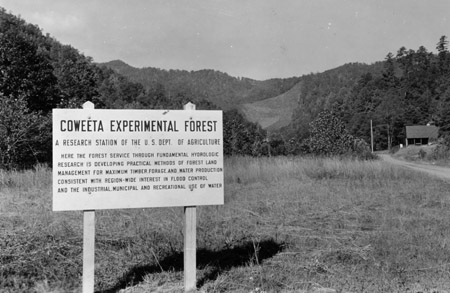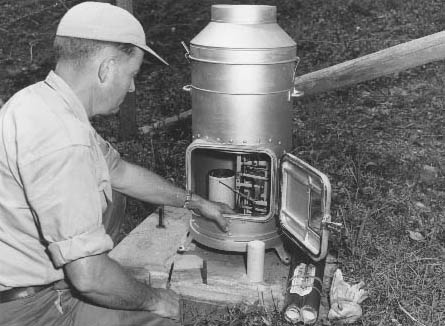Coweeta Hydrologic Lab Celebrates 75 Years
In 1934, the Coweeta Experimental Forest was officially established on the Nantahala National Forest. Occupying nearly 4,000 acres just north of the North Carolina-Georgia border and renamed the Coweeta Hydrologic Laboratory in 1948, the site would prove to be the source of some of the most influential research on forested watersheds done in the world. This week a symposium to mark the 75th anniversary of Coweeta will look at the development of watershed science and celebrate the important research which continues to be done there.
The story of Coweeta begins with Dr. Charles R. Hursh, who was hired in 1926 as a researcher at the Appalachian Forest Experiment Station (now the Southern Research Station) in Asheville, NC. Much of Hursh's work was in streamflow and erosion studies, which led him to formulate broader theories of forests and water supply. Hursh identified the Coweeta Basin (in the Appalachian Mountains just south of Franklin, NC) as an ideal spot to locate a permanent research station to study the impacts of forest management practices on soil and water. Hursh was given access to the site and began informal research there, during which time an order establishing the Coweeta Experimental Forest was signed on June 1933 and then officially approved by Chief Ferdinand Silcox on March 28, 1934.

Coweeta Experimental Forest entrance sign with administrative building at right, 1942.
Workers from the nearby Civilian Conservation Corps Camp in Franklin, NC (CCC Camp NC-23) built roads, buildings, testing stations, and other installations on the site. With limited resources and staffing, Hursh was still able to turn the site into an extensive hydrological laboratory and research station. Early studies looked at the effects of logging, farming, and woodland grazing on forest watersheds. Data gathered at the site was also used for important research in areas such as riparian vegetation and water supply; the properties of groundwater movement through soil; relationships between the atmosphere, environment, and forest watersheds; and the use of road banks for erosion control.

Image of rain gauge recording instrument at Coweeta, from a 1953 USFS publication.
The laboratory's profile was further raised in 1955, when the Forest Service produced the film "The Waters of Coweeta" to increase nationwide awareness of the importance of watershed management and research.
The arrival of researcher Wayne T. Swank at the laboratory in the 1960s ensured the continuation of Coweeta's influential work. Swank spent more than 30 years at Coweeta, serving as project leader from 1984 to 1999, and helped to expand the successful research operations at the site. Cooperative work with the University of Georgia's Institute of Ecology began in 1968, and produced an ongoing valuable partnership. Coweeta also became a National Science Foundation Long-Term Ecological Research site in 1980. More recent years have seen the work shift to new areas of study such as water quality research, acid rain, invasive pests, and prescribed fire.
Through the years, Coweeta has maintained its importance as one of the oldest continuous environmental research studies in the world. The hydrologic research there has shown how forest ecosystems can be responsibly managed without ruining valuable water resources. Significant research in new areas ensures that Coweeta will remain as a center of forest research long into the future.
For more information on the history of the Coweeta Hydrologic Laboratory, see the following FHS resources:
- "Forest Watershed Research in the United States" by George G. Ice and John D. Stednick, from Forest History Today, Spring/Fall 2004
- Oral History Interview with Wayne T. Swank, conducted in 2005
- "Waters of Coweeta" USFS publication, 1953
- U.S. Forest Service History Collection watershed publication files
- USFS Collection Biographical File on Wayne Swank

